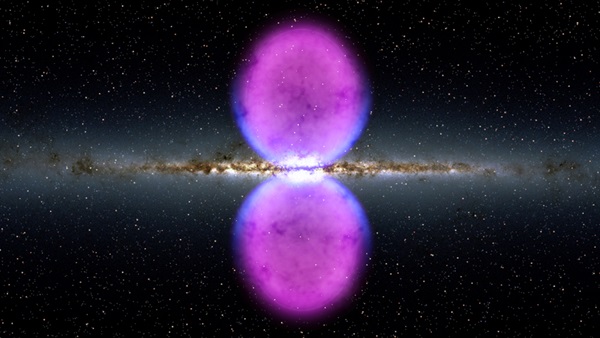Key Takeaways:
In November 2010, astronomers using NASA’s Fermi Gamma-ray Space Telescope announced an astonishing discovery. Emanating from the center of our Milky Way Galaxy are two bubbles made solely of powerful gamma rays.
This would have been strange enough if the bubbles, expanding at 2.2 million mph (3.5 million km/h), were concentric — a bubble within a bubble — with both centered at the galaxy’s core. But no, the two enormous spheres each hover in seemingly empty space above and below the black hole in the Milky Way’s nucleus. They are tangent to each other, touching at the galactic center to form a squat hourglass shape. The entire structure looks like the number 8 or a sideways infinity symbol.
Gamma rays are the bad boys of the electromagnetic spectrum — the highest-energy photons in the universe. To review high school physics, a photon’s energy is a function of its waves’ lengths. Radiation whose waves are a mile apart (radio waves) are weak and benign; visible light has microscopically close-together waves; X-rays, and especially gamma rays, are crammed together with the maximum number of wave crests passing a given point per second.
Because of this, gamma rays do not reliably reflect off objects the way visible light does. Rather, they penetrate stuff. Their photons drill through human bodies at the speed of light, damaging chromosomes along the way.
Fortunately, few gamma rays reach us here at Earth’s surface. Although the Sun creates copious gamma rays in its fusion furnace, they are absorbed and re-radiated as gentler forms of light as they squirm upward to the solar surface. What finally flies away from the Sun is a roughly 50-50 mixture of heat and visible light and virtually no X-rays or gamma rays at all.
Other stars don’t emit them either, and, in any case, Earth’s atmosphere blocks them. The only gamma rays flying near us come from distant violent events like supernovae. This is why a dense gamma-ray swarm at our galaxy’s center is so puzzling. It’s the unmistakable sign of extreme violence. And yet, these days, the Milky Way’s core is about as energetic as a steamy July lunchtime in New Orleans.
These bubbles are sharp-edged, well-defined, and nothing short of enormous. The top and bottom of the “figure 8” extends 25,000 light-years above the galactic plane and the same distance beneath it. From our sideways viewpoint 26,000 light-years from the Milky Way’s center, the hourglass stands a whopping 45° above and below the galactic core, in the constellation Sagittarius. It takes up half of our southern sky.
Theorists need to explain more than just what could have produced this kind of extreme energy, which is equivalent to 100,000 exploding supernovae. They must also explain the off-center nature of the bubbles because each seemingly surrounds nothingness.
Jon Morse, director of the astrophysics division at NASA, summed up the discovery at a press conference: “It shows, once again, that the universe is full of surprises.” This gargantuan hourglass — which researchers are starting to call the Fermi Bubbles, in honor of the orbiting gamma-ray telescope launched in 2008 that found them — is now regarded as an entirely new type of astronomical object in the known universe.
Trying to come up with some explanation for our galaxy blowing bubbles at temperatures of 7 million degrees Fahrenheit (3.9 million degrees Celsius), many astrophysicists have expressed a gratifying unanimity: “We have no idea.” Others, starting perforce from square one, have posited a couple of vague possible causes. The first theory is that, perhaps a few million years ago, a burst of star formation at the galactic center created numerous massive stars, all with high-speed winds of high-energy particles. Because this alone could not begin to explain the super-high energy within the bubbles, that theory further imagines that many of these stars blew up into supernovae simultaneously.
Don’t like that one? Neither do I. So let’s go to the second possible explanation, which is that the 4-million-solar-mass black hole at our galaxy’s center had a brief feasting frenzy when much captured material was accelerated within its event horizon. Then, perhaps, that black hole could have developed something it does not presently have: twin jets of outrushing material. We see such jets exploding from the supermassive black holes in a few other galaxies (see M87, number 25 on our list, for example). These jets could have possibly deposited energetic material above and below the galactic plane, although how these bubbles then emanated from those positions is anyone’s guess.
The ultimate answer could be even stranger. Might these be the long-sought signs of dark matter? Could dark matter be meeting its opposite entity (whatever that is) in total annihilation, the way matter and antimatter do? More likely, however, is that this is something else entirely, some new phenom that will actually get in the way of the dark matter hunt.
As Douglas Finkbeiner, an astronomer at the Harvard-Smithsonian Center for Astrophysics in Cambridge, Massachusetts, who first discovered the structure, put it, “It just confuses everything.”











